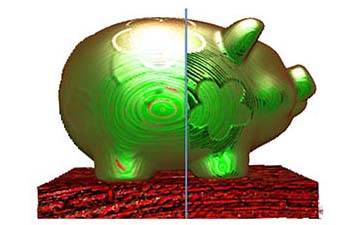Guidance On The Selection Of Central Difference Method Accuracy In Volume Rendering

|
Guidance On The Selection Of Central Difference Method Accuracy In Volume Rendering |
Abstract
In many applications, such as medical diagnosis, correctness of volume rendered images is very important. The most commonly used method for gradient calculation in these volume renderings is the Central Difference Method (CDM), due to its ease of implementation and fast computation. In this paper, artifacts from using CDM for gradient calculation in volume rendering are studied. Gradients are, in general, calculated by CDM with second-order accuracy, $mathcal{O}(Delta x^2)$. We first introduce a simple technique to find the equations for any desired order of CDM. We then compare the $mathcal{O}(Delta x^2)$, $mathcal{O}(Delta x^4)$, and $mathcal{O}(Delta x^6)$ accuracy versions, using the $mathcal{O}(Delta x^6)$ version as “ground truth”. Our results show that, unsurprisingly, $mathcal{O}(Delta x^2)$ has a greater number of errors than $mathcal{O}(Delta x^4)$, with some of those errors leading to changes in the appearance of images. In addition, we found that, in our implementation, $mathcal{O}(Delta x^2)$ and $mathcal{O}(Delta x^4)$ had virtually identical computation time. Finally, we discuss conditions where the higher-order versions may in fact produce less accurate images than the standard $mathcal{O}(Delta x^2)$. From these results, we provide guidance to software developers on choosing the appropriate CDM, based upon their use case.
Downloads
Citation
Kazuhiro Nagai, and Paul Rosen. Guidance On The Selection Of Central Difference Method Accuracy In Volume Rendering. Lecture Notes in Computer Science: Advances in Visual Computing, 2015.
Bibtex
@inproceedings{nagai2015guidance,
title = {Guidance on the Selection of Central Difference Method Accuracy in Volume
Rendering},
author = {Nagai, Kazuhiro and Rosen, Paul},
booktitle = {Lecture Notes in Computer Science: Advances in Visual Computing},
pages = {328--338},
year = {2015},
note = {textit{Presented at the International Symposium on Visual Computing 2015.}},
abstract = {In many applications, such as medical diagnosis, correctness of volume
rendered images is very important. The most commonly used method for gradient
calculation in these volume renderings is the Central Difference Method (CDM), due to
its ease of implementation and fast computation. In this paper, artifacts from using CDM
for gradient calculation in volume rendering are studied. Gradients are, in general,
calculated by CDM with second-order accuracy, $mathcal{O}(Delta x^2)$. We first
introduce a simple technique to find the equations for any desired order of CDM. We then
compare the $mathcal{O}(Delta x^2)$, $mathcal{O}(Delta x^4)$, and
$mathcal{O}(Delta x^6)$ accuracy versions, using the $mathcal{O}(Delta x^6)$ version
as ``ground truth''. Our results show that, unsurprisingly, $mathcal{O}(Delta x^2)$
has a greater number of errors than $mathcal{O}(Delta x^4)$, with some of those errors
leading to changes in the appearance of images. In addition, we found that, in our
implementation, $mathcal{O}(Delta x^2)$ and $mathcal{O}(Delta x^4)$ had virtually
identical computation time. Finally, we discuss conditions where the higher-order
versions may in fact produce less accurate images than the standard $mathcal{O}(Delta
x^2)$. From these results, we provide guidance to software developers on choosing the
appropriate CDM, based upon their use case.}
}




